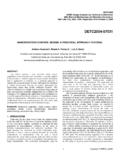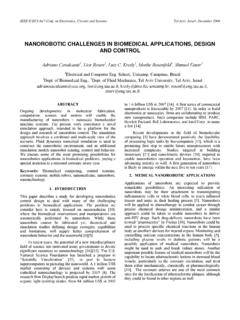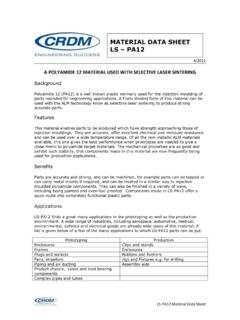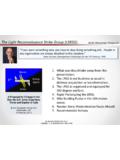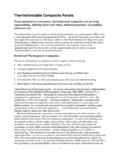Transcription of IOPPUBLISHING N …
1 IOP PUBLISHING NANOTECHNOLOGY. Nanotechnology 19 (2008) 015103 (15pp) Nanorobot architecture for medical target identi cation Adriano Cavalcanti1,2 , Bijan Shirinzadeh2, Robert A Freitas Jr3 and Tad Hogg4. 1. CAN Center for Automation in Nanobiotech, Melbourne VIC 3168, Australia 2. Robotics and Mechatronics Research Laboratory, Department of Mechanical Engineering, Monash University, Clayton, Melbourne VIC 3800, Australia 3. Institute for Molecular Manufacturing, Pilot Hill, CA 95664, USA. 4. Hewlett-Packard Laboratories, Palo Alto, CA 94304, USA. E-mail: Received 30 March 2007, in nal form 17 October 2007. Published 29 November 2007. Online at Abstract This work has an innovative approach for the development of nanorobots with sensors for medicine. The nanorobots operate in a virtual environment comparing random, thermal and chemical control techniques.
2 The nanorobot architecture model has nanobioelectronics as the basis for manufacturing integrated system devices with embedded nanobiosensors and actuators, which facilitates its application for medical target identi cation and drug delivery. The nanorobot interaction with the described workspace shows how time actuation is improved based on sensor capabilities. Therefore, our work addresses the control and the architecture design for developing practical molecular machines. Advances in nanotechnology are enabling manufacturing nanosensors and actuators through nanobioelectronics and biologically inspired devices. Analysis of integrated system modeling is one important aspect for supporting nanotechnology in the fast development towards one of the most challenging new elds of science: molecular machines. The use of 3D simulation can provide interactive tools for addressing nanorobot choices on sensing, hardware architecture design, manufacturing approaches, and control methodology investigation.
3 (Some gures in this article are in colour only in the electronic version). 1. Introduction advances on health care sector [18 23]. Through the use of nanotechnology techniques [24], advances on genetics This paper presents the architecture and the simulation and biomolecular computing [25], biological nanorobots can of nanorobots using sensor capability for medical target be applied to advance medicine [26]. For example, in identi cation. Nanorobots are expected to enable signi cant microbiology engineering the construction of digital circuits new methodologies in diagnosis, medical therapies, and in living cells has been demonstrated [27]. Bacteria have minimally invasive surgery [1 4]. In our work we demonstrate been used as physical system components [28], and radio a computational and analytical new approach to help in the remote control of biological processes has been demonstrated research and development of nanorobots [5, 6].
4 Experimentally [29]. Some proposals on rigid materials A rst series of nanotechnology prototypes for molecular with positional mechanosynthesis [30, 31], and manufacturing machines are being investigated in different ways [2, 7 12], nanodevices were presented [7, 13, 32]. Recent developments and some interesting device propulsion and sensing approaches in biomolecular computing have demonstrated the feasibility have been presented [13 16]. Some work has been done in of biocomputers [33], a promising rst step toward future 2D on cellular automata with the examination of collective nanoprocessors. Other examples include studies of building behaviors of large numbers of robots to locate speci c types of biosensors and nanokinetic devices [7, 8, 13, 19, 34]. tissue [17]. More complex molecular machines, or nanorobots, Real time three-dimensional (3D) prototyping and sim- having embedded nanoscopic features may provide broad ulation are important tools for nanotechnology development.
5 0957-4484/08/ 015103 +15$ 1 2008 IOP Publishing Ltd Printed in the UK. Nanotechnology 19 (2008) 015103 A Cavalcanti et al Such tools have signi cantly helped the semiconductor in- 3. Medical nanorobotics dustry to achieve faster VLSI (very large scale integration). development [35]. It should similarly have a direct impact The feasibility of advancing techniques for control [5] and on the implementation of nanomanufacturing techniques and manufacturing molecular machines should be understood also on nanoelectronics progress [36]. Simulation can antic- as emergent results from actual and upcoming stages of ipate performance and help in new device design and manu- nanotechnology, based on nanoelectronics [8, 52], new facturing [37, 38], nanomechatronics control design and hard- materials [53 55] and genomics research [56].
6 New ware implementation [8, 39]. The use of scienti c visualiza- possibilities are coming from these developments which will tion is a powerful tool for the purpose of designing devices enable new medical procedures [1, 18, 21, 26, 53, 57]. at nanoscale [40]. In our work, the focus of interaction and The nanorobot proposed prototyping must be equipped sensing with nanorobots is addressed giving details on the with the necessary devices for monitoring the most important workspace chemical and thermal signals dispersion through a aspects of its operational workspace. For biomedical 3D environment as a testbed for prototyping and analysis. The application the temperature, concentration of chemicals in nanorobots must search proteins in a dynamic virtual environ- the blood, and electromagnetic signatures are some of the ment and use different strategies to identify and bring those relevant parameters when monitoring the human body to detect proteins for medical delivery.
7 Some diseases [58, 59]. The application of new materials has demonstrated a large range of possibilities for use in 2. Motivation manufacturing better sensors and actuators with nanoscale sizes [14, 35]. This downscaling will continue, according to the Considering the properties of nanorobots to navigate as Semiconductor Industry Association's roadmap. By 2016, high bloodborne devices, they can help important treatment performance ICs will contain more than billion transistors processes of complex diseases in early diagnosis and in a 280 mm2 area more than 25 times as many as on today's smart drug delivery [41]. A nanorobot can provide chips built with 130 nm (nanometers) feature sizes [60]. Those ef cient early diagnosis of cancer and help with smart developments allied with 3D simulation should facilitate the chemotherapy for drug delivery.
8 Nanorobots as drug manufacturing design of nanorobots with integrated embedded carriers for timely dosage regimens allows maintaining the nanoelectronics and circuits. chemical compounds for a longer time as necessary into the bloodstream circulation, providing predicted pharmacokinetic 4. Background parameters for chemotherapy in anti-cancer treatments [42]. It avoids the current resulting extravasations towards non- Current developments in nanoelectronics [36] and nanobiotech- reticuloendothelial-located cancers with the high degenerative nology [61] is providing feasible development pathways to en- side-effects during chemotherapeutic process [43]. Nanorobots able molecular machine manufacturing, including embedded with chemical nanobiosensors can be programmed to detect and integrated devices which can comprise the main sensing, different levels of E-cadherin and beta-catenin as medical actuation, data transmission, remote control uploading, and targets in primary and metastatic phases [44 46], helping target coupling power supply subsystems addressing the basics for identi cation and drug delivery.
9 Operation of medical nanorobots. In terms of diagnosis, a critical issue in cerebral aneurysm A recent actuator with biologically-based components has is to detect and locate vessel dilation, if possible before been proposed [62]. This actuator has a mobile member a subarachnoid hemorrhage occurs. Similarly, nanorobots that moves substantially linearly as a result of a biomolecular using chemical sensors as embedded nanoelectronics can be interaction between biologically-based components within programmed to detect different levels of nitric oxide synthase the actuator. Such actuators can be utilized in nanoscale (NOS) pattern signals as medical targets in early stages mechanical devices to pump uids, open and close valves, or of aneurysm development [47]. Integrated nanobiosensors to provide translational movement.
10 And radio frequency (RF) wireless communication [8] can To help control the nanorobot's position, a system for be utilized for such a task in order to nd changes of tracking an object in space can comprise a transponder device gradients for NOS concentrations [48]. Chemical signals connectable to the object. The transponder device has one can also be useful for nanorobot medical target identi cation or several transponder antennas through which a transponder and actuation in another cerebral treatment. The amyloid- circuit receives an RF signal. The transponder device adds protein deposits show changes on gradients as a symptom a known delay to the RF signal thereby producing an RF. of Alzheimer disease [49, 50]. This information serves response for transmitting through the transponder antenna [63]. for the early diagnosis of Alzheimer disease and to guide A series of several transmitters and antennas allow a position possible immunotherapy treatments, with more ef cient calculator associated with the transmitters and receivers to neurotransmitters delivery, like dopamine and amino acids calculate the position of the object as a function of the known such as g-aminobutyrate (GABA), with better medical delay and the time period between the emission of the RF.
